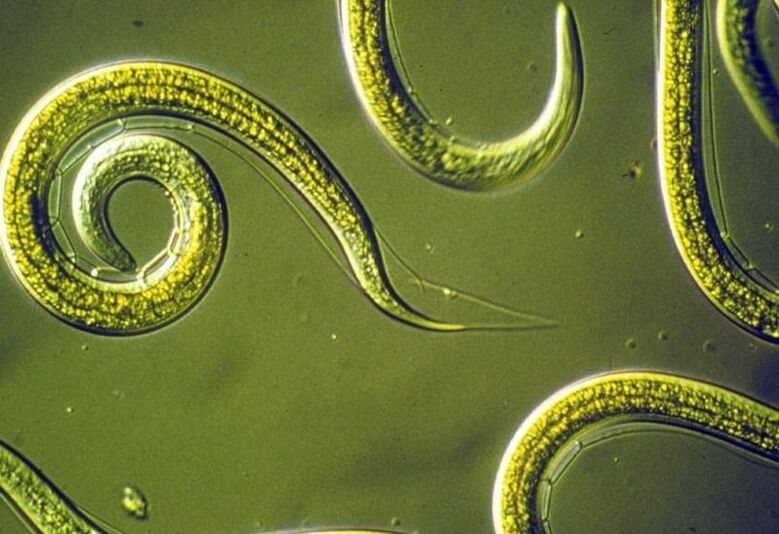Unfortunately, even in modern advanced times, there is a risk of infection with helminths. To treat and prevent this phenomenon, it is necessary to at least get acquainted with the main types of worms.
Types of worms
In medical sources where you can find the answer to the question of what kind of worms a person has, they give information about many types. Of course, some types are the most common. According to their classification, they can be divided into 3 main types. These are: round and tapeworms, as well as flukes.
roundworms
The first on the list of types of worms in humans is roundworms. They are also called nematodes. They got their name due to the structure of the body, because if you make a cross section of an individual, you can see the roundness as a result. Although there are more than 20 thousand species in the world, only a few of them are commonly found in humans.
The most common roundworms include:
- Roundworm. These worms are quite large. Their length can reach half a meter. The width varies between 4-5 cm. The color is usually pink, but in different cases it can be more white or more red. These helminths are mainly localized in the small intestine, but rarely in the biliary tract. Larvae also move through the body quite easily with the bloodstream. Their last stop is the lungs. It is here that there are the most comfortable conditions for their growth, because this type of parasite belongs to anaerobes. When they are more alive, they pass into the intestines. The lifespan of roundworms can be 12-14 months. Outside the human body, these worms live in soil conditions where they lay several thousand eggs daily;
- Pinworms. It is most common in children, as the cause of infection can be poorly washed hands or products. They enter the body with slightly less dust particles. Their size is much smaller than roundworms. The length of males reaches 3 mm, and females 13-14 mm. Its color is completely white. Their favorite habitat is the starting part of the large intestine. Eggs are laid closer to the anus. Their lifespan is also much shorter than roundworms and is only a few months.
- Trichinella. Measuring only 4 mm in length, these modest-sized worms often enter the living human body as part of infected meat. Larvae live in muscle tissue, mainly in oculomotor and masticatory tissues, but adults prefer localization in the intestines. Trichinella is a danger to humans because it can be fatal without proper treatment.

Tapeworms
Tapeworms are characterized by a flat body structure and complete absence of a gastrointestinal tract. The length of individuals can reach several meters, so they look like a long ribbon. They prefer to live in the intestines or stomach canals. Among them are the following types:
- Taurus built a ribbon. This is one of the largest species of tapeworms. The length of an individual can reach 15-20 meters. The worm attaches itself to the surface of the small intestine and begins to absorb substances necessary for humans. It can live up to 10 years without proper diagnosis and treatment. Infection usually occurs by eating contaminated, undercooked meat;
- The dwarf built a ribbon. It got its name due to its small size, which is 4-5 mm on average. You can get infected with a tapeworm through poorly washed vegetables and even dirty hands;
- Wide tape. Another great sight. It can be up to 10 meters long, and its width is usually larger than other worms. Larvae enter the body together with infected fish and grow in just 3. 5 weeks. It lives mainly in the small intestine. Lifespan can reach decades;
- Echinococcus. Small worms, usually no more than 5 mm in length. Infection occurs from infected animals: cats and dogs. This type is distinguished by the localization of individuals not in the intestines, but in the lungs or liver. They are dangerous because they can cause the formation of cysts, which later require surgical removal.
These worms can do a lot of damage to the body, so the sooner they are detected, the better.
flakes
Flukes, like tapeworms, are flat parasites in body structure. They are also called liver worms because their main habitat is the liver and bile ducts. Their main types are:
- Fluke. Also known as a cat trap. It lives mainly in rivers and lakes, that is, it enters the human body together with poorly processed infected fish. Pets can act as carriers. Individuals are quite small and rarely reach 12-13 mm. Inside a person, they can live in absolutely any organ;
- Chinese or oriental flavor. It is characterized by the transparent red tone of the body and its small size, no more than 2. 5 cm. It enters the human body, the same as a regular rifle. It can lay more than 3. 5 thousand eggs per day;
- Fasciola. This is a larger flatworm, it can be 5-7 cm long. It can live only in fresh water conditions. It dies in salty springs. A person can become infected with fasciola by drinking raw contaminated water, such as when bathing, and also by eating the plant. The risk is especially great in the case of aquatic or wild species.
Even though liver plugs are small in size, they can be dangerous for humans. The patient may develop fever in addition to standard symptoms.
The simplest organisms
The simplest organisms have existed on earth for millions of years. To date, science studies more than 14, 5 thousand species. Like other parasites, their favorite habitat is soil, water in reservoirs and, of course, the human body. They can remain on the surface of vegetables and fruits for some time, their use often leads to infection.
In most cases, when it comes to infecting a person with protozoa, it is Giardia that is meant. Their vitality is to be envied. They tolerate even the most unfavorable environmental conditions.
In their structure, they differ in the presence of four pairs of flagella and a special disc that performs the function of suction. Thanks to them, Giardia reliably adheres to the inner surface of the intestine and begins to parasitize.
Manifestation symptoms
The appearance of worms in the human body can be understood by many signs. However, most of them are general in nature, indicating the presence of an inflammatory process. This can confuse the patient, forcing him to look for the cause in other diseases.
Thus, the patient can record himself during this period:
- Fatigue, weakness, tiredness;
- Paleness of the skin;
- Dizziness and sometimes headache;
- Increased anxiety, irritability. Significant aggression can be observed in children;
- Poor sleep. Usually worried about insomnia;
- Pain in the joints, pulling sensations in the muscles;
- Increased saliva.

Fatigue is one of the symptoms of the presence of worms.
The following symptoms, reminiscent of an allergic reaction or diseases of the gastrointestinal tract, may confuse the patient:
- Jaundice of the skin;
- Rash on the body;
- attacks of bronchial asthma;
- Faecal disorders: constipation or diarrhea;
- flatulence;
- A feeling of nausea, as well as vomiting;
- Pain in the abdomen and hypochondrium;
- A slight rise in body temperature.
But the more typical symptoms for this condition, so people most often begin to suspect that it is a parasite:
- Losing weight for no reason. At the same time, it becomes very difficult to return lost kilograms;
- Itching in the anus;
- Bruxism. This phenomenon is expressed by clenching the teeth during sleep.
Although there are many signs of the presence of parasites in the body, sometimes this phenomenon is completely asymptomatic, and therefore people can be unaware of it for months.
Diagnostics
It is not easy to identify helminths in the body. In this case, the standard procedure is to examine the feces for eggworms. I will say that sometimes it may be necessary to conduct an analysis 3-5 times to detect worms in feces.
Only a doctor knows how to identify certain types of worms. Without test results, it is impossible to do it yourself. Depending on the existing symptoms, the doctor may prescribe the following examination procedures:
- Blood test. In this case, the number of indicators such as proteins and eosinophils is analyzed;
- Analysis of scraps from the anus;
- Vaginal scraping analysis.
Also, in some cases, additional measures may be required. Whom:
- Sputum examination;
- Study of urine and bile composition;
- endoscopy;
- CT scan;
- Ultrasound procedure.
After the parasites are identified, the doctor draws up a treatment plan.
Treatment
Self-treatment of parasites is not allowed. This is due to the following factors:
- Preparations contain different active substances, that is, they have a harmful effect on different types of helminths;
- Some drugs are able to destroy only the larvae of worms, but not the adults;
- All medications have some side effects.
In this regard, it is necessary to select drugs based on the results of diagnostic procedures.
Preparations may have the following active ingredients:
- mebendazole. Affects only pinworms;
- Diethylcarbamazine. If the patient has filaria in his body, drugs based on it are prescribed;
- Levamisole. It has a wide range of activities. Destroys both pinworms and roundworms, as well as other worms;
- Hydroxysinaphtoate bephenia. Effectively fights tuber worms;
- Albendazole. It is necessary in the treatment of diseases caused by echinococci;
- Piperazine adipate. It is used to remove roundworms and pinworms from the body.
Traditional medicine is not left out in this matter either. It always offers different ways that cannot completely rid the body of parasites, but can at least slow down their reproduction and development.

Examples of such methods include:
- Pumpkin seeds. They are taken in pure form or a decoction is prepared based on them;
- Watermelon seeds. Apply the same to the pumpkin;
- wormwood tincture;
- Alcohol and wormwood tincture;
- garlic;
- tansy;
- Sandy Immortal.
It is important to pay attention to the fact that before using folk methods, you must get permission from your doctor and, of course, exclude an allergic reaction to the components used.
What are dangerous worms for humans?
Worms not only live in the human body, they literally parasitize, take useful substances, and also suck blood. The body experiences a state of intoxication. The long-term stay of helminths in a person can lead to such negative consequences:
- Weakening of the immune system;
- Disturbance of the gastrointestinal tract. Poor digestion of food, the appearance of ulcers;
- Development of allergy;
- formation of cysts;
- Damage to the organs they live in.
Remember that some types of parasites are very, very dangerous. Ignoring their presence can lead to the worst outcome.
Prevention
The vast majority of people have encountered worms at least once in their lives. Children are especially affected by it. And this is quite right, in addition to the fact that they have weaker immunity than adults, they often ignore the rules of hygiene.
In general, methods that help reduce the risk of infection are not complicated. They say to themselves:
- Observance of personal hygiene rules. Hands should not only be washed, but thoroughly washed with soap;
- Vegetables, fruits, berries should be washed with plenty of water;
- Any meat: beef, poultry or fish should be washed very well before eating. Heat treatment should also be thorough. If there is no confidence in its quality and safety, it is not worth taking a risk and cooking meat with blood;
- Periodic anthelmintic prophylaxis in children. It is best to do this by consulting a doctor;
- Also, livestock and domestic animals are subject to drug prophylaxis. At the same time, there is no difference whether they live in the courtyard of a private house or in the room itself. If a dog or cat eats raw meat, worm prevention must be done.
Such procedures will help to avoid encountering parasites for as long as possible.



























